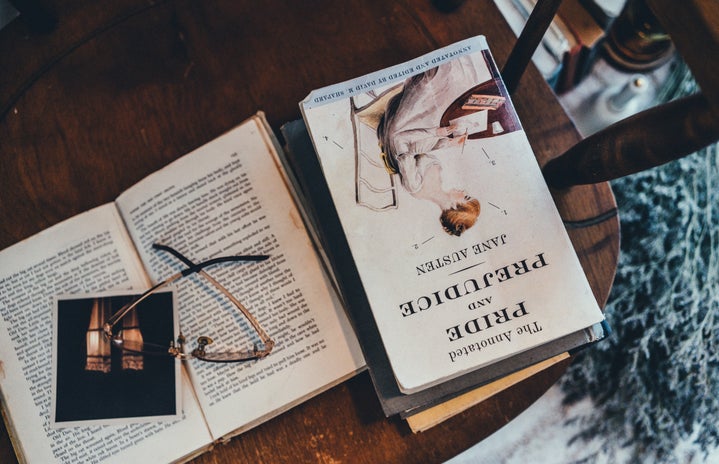Feminist literature is a general term used to describe a collection of works that display the philosophy and standpoints of feminism. Essentially you can tell when a novel you’re reading falls under this subsection of literature when you feel that the writer innately urges readers to consider the importance of ending sexism. However, categorizing which books may fall under feminist literature is not as straightforward as it sounds. Considering the complex nature of this topic and the fact that it can be regarded as a form of study, I will only begin to scrape the surface of this essential and groundbreaking source of feminism. However, through a quick run-down of its history, we can try to identify common patterns from the past and determine what we might expect in the future. Although inequality and sexism remain apparent, feminism has earned more attention. Women now have a bigger platform for voicing their opinions and struggles, meaning the world of feminist literature can grow more than ever before. So, what can we expect to see more of in libraries and our Goodreads recommendations in the near future in terms of feminist literature?
Regarding the birth of feminist literature, it’s essential to look back at the history and the rise of this literary movement, beginning with some of the most notable female writers in the 18th and 19th centuries. The first one of note would be Mary Wollstonecraft. She wrote the Vindication of the Rights of Women in 1792, which highlighted the inequalities between men and women and put forward the importance of proper education for women. Her views were the most intense of her time and directly targeted the issues surrounding gender inequalities, something to which the society of the day was unaccustomed. Today we regard women of the 19th century, such as Louisa May Alcott, Jane Austen, the Brontë sisters and Mary Anne Evans (who went by the name George Eliot), to have impacted feminist portrayals in the world of literature – even though their work was not used as a medium by feminist movements. So, when comparing Wollstonecraft to these women, it’s important to note the difference in how they affected their societies and the world of feminist literature. Because Wollstonecraft directly challenged the system, her work was utilized in later feminist writings. Whereas the women of the 19th century mentioned above were famous for their subtle ways of rewriting the way a woman could behave in their given society through fictional storylines. Their stories often dealt with themes such as family, romance, duty, and health because these topics were relevant to their readers and pinpointed challenges they might face. Novels such as Emma or Pride & Prejudice are regarded as romantic classics and yet they have hidden feminist undertones evident in the way their female leads respond to societal expectations. Elizabeth Bennet, for example, is a quick-witted character that appreciates reading despite the fact that women were brought up to be married off and become housewives, rather than becoming educated. Representing a woman with such intellectual capacity went against the confining ways of their time. Thus, Austen subtly hinted at the idea that women can create their own identity outside of the one society expects of them, and that women do not have to leave the academic field to men. Moreover, in Little Women alone, for example, we see how each sister responds differently to the idea of marriage – in doing so Alcott points out the strict ways in which families upheld the status quo and how it did not, necessarily, define a woman’s happiness. This was a children’s book, and through creating Jo March, who not only turned down a marriage offer but dreamed of being a writer herself, Alcott inadvertently tells young girls that there was more to life than the simple ideas if marriage and duty put before them. Thus, these women of the 18th and 19th centuries wrote despite indoctrination suggesting that women are not capable of intellectual freedom or free will when it comes to marriage, duty, and responsibilities, which will forever signify a great deal to female writers of today. However, the question of when exactly the world of feminist literature blew up remains unsolved because although these early centuries showed hints of the introduction of feminist literature, these novels never quite cemented the idea of feminist literature.
The direct transition between the female authors of the 19th century and 20th century is not easy to distinguish. Some other, most likely female, writers contributed to its growth as we moved on to the next century. However, the next influential phase came in the 1900s, particularly around the 1920s and 1960s. Due to the many wars and other significant historical events in the 1900s, men were sent off to fight while women had to stay home and provide for their families. And while this did suppress women under the patriarchy in the literal sense, it also gave room for the feminist movement to grow and expand. The 1920s did not fully recognize women writers because the war victories essentially overshadowed the attention given to them; however, this is not to say that the opinions expressed during this time went unnoticed. One of the most influential writers to mention here must be Virginia Woolf. She was famous for Mrs. Dalloway (1925) and To the Lighthouse (1927), which would later become valuable texts in expanding the feminist movement. She also wrote many essays on the topic of women’s writing. In the 1960s and 1970s, the increased protest action due to the cultural revolution meant that women of the time seized the opportunity to organise feminist political activism alongside other protests. This is where writers like Simone de Beauvoir and Kate Millet come in for their feminist theories and literary criticism. The atmosphere of political and social unrest accelerated the growth of the feminist literary movement and even cemented it. Moving to the 1990s, we can see the feminist literary world expanding, including women outside the white, heterosexual middle class that had previously dominated this field. Writers such as Alice Walker, who is well known for The Color Purple, took the idea of gender inequality and applied it to specific examples and struggles. Her novel aims at attracting more attention to the battle an African American woman faces, which shows the level of evolution that the feminist literary world has taken as of late, and how the idea of gender inequality should be applied and considered alongside other social constructs that these women face in their everyday lives.
What we can expect to see in the future in terms of the feminist literary world will resemble a continuation of feminism, applied to other specific social struggles that we have seen in feminist literature from the 1990s up until now. However, I think the future of feminist literature will have to dive deeper than ever before by targeting and redefining what constitutes feminism itself. If Bell Hooks said that ‘feminism is a movement to end sexism, sexist exploitation, and oppression,’ then the literary field should accommodate and make up for the lack of representation it has had towards people who identify as nonbinary, for example. In the past, feminist literature has brought attention to the inequality between men and women, specifically in white communities. The women writers of the 18th, 19th, and 20th centuries have achieved their goal and contributed to the platform that feminism now has; however, their work does not resemble the end of the fight for social equality.
Their work brought attention to the struggle, but now it is our job, in the 21st century, to better the feminist movement through literary means. We need to ask ourselves why other social issues such as race and sexuality are treated as separate from the feminist movement when, in real life, we cannot divide our identity in this way. Feminism should move away from being known as a fight for women’s freedom and issues relating to womanhood, as according to social activist Bell Hooks, it has more to do with the issue of sexism. All are affected by sexism, and once feminist writers adopt the viewpoint that feminism can be an umbrella term for matters relating to sexism, then the future of feminist literature can embrace decolonization in mainstream feminism.
Another thing we can expect to see is more authors writing about their struggles and experiences, whether through autobiographies or fictional stories that reflect their own experiences. Women now have a more powerful social platform and are able to publish their work or be a proud career woman without facing societal backlash, as was the case in the past. As such more authors will see opportunities to share their stories and enlighten the world about their struggles. Moreover, I think these authors will bridge the gap between fictional feminist characters and head-on feminist manifestos. In the past, we have seen feminist authors write both fictional stories with underlying feminist aspects and essays targeting the issues within the patriarchy. However, these two were kept separate. Thus, in the future, I think more authors will try to figure out a way to write a manifesto within a fictional story to heighten the message of their novel alone.
Feminist literature has also primarily expanded to include children as their audience, and in the future, we can expect this to be a huge potential area for feminist influence. By first looking at YA novels, we can see how main characters often enter a “coming of age” dilemma that involves life choices and a sense of independence. Although this is not necessarily an overt acknowledgment of feminist literature, it can signify that there is and will be an organic inclination towards questioning the way society is structured in the writing of YA novels. Children’s books will also be written with an open-minded approach because the depiction of basic social dynamics will be re-assessed. I think more books will be written from the feminine point of view, and characters will not be distinguished as male or female as directly as they have been previously. For example, the big and buff characters are often given masculine names, and the petite ones are given feminine names. This essentially created the idea that there is a line between what society accepts as masculine and feminine, which will stay with the child as they grow older and navigate the social pressures of gender themselves. This brings me to my next point about how we should expect to see feminist literature targeting gender performativity by addressing the issues surrounding socially accepted behaviors designated to each gender, such as the idea that men are not used to being seen wearing dresses. This is also mainly due to what is accepted in different cultures and what has been taught to us by our elders. I think the future of feminist literature will reveal a space that allows for questioning these constructs and for the representation of nonconformity.
I think the future of feminist literature will showcase its most significant transformation leap compared to its path thus far. The growth of this movement has shown a substantial evolution in the past 50 years and because of this we can expect transformation to occur sooner than we might have thought. Feminist literature has the power to influence and alter the way the general population views social injustices. If there is anything that we have taken from its history is that feminism itself can be built around the views and opinions brought forward by feminist writers. Literature has a way of changing the way we see the world, and the future of feminist literature will do just that.


